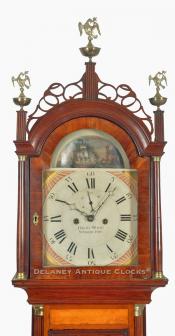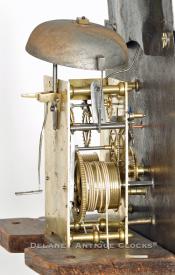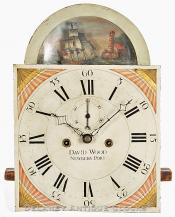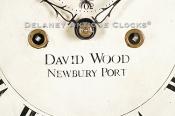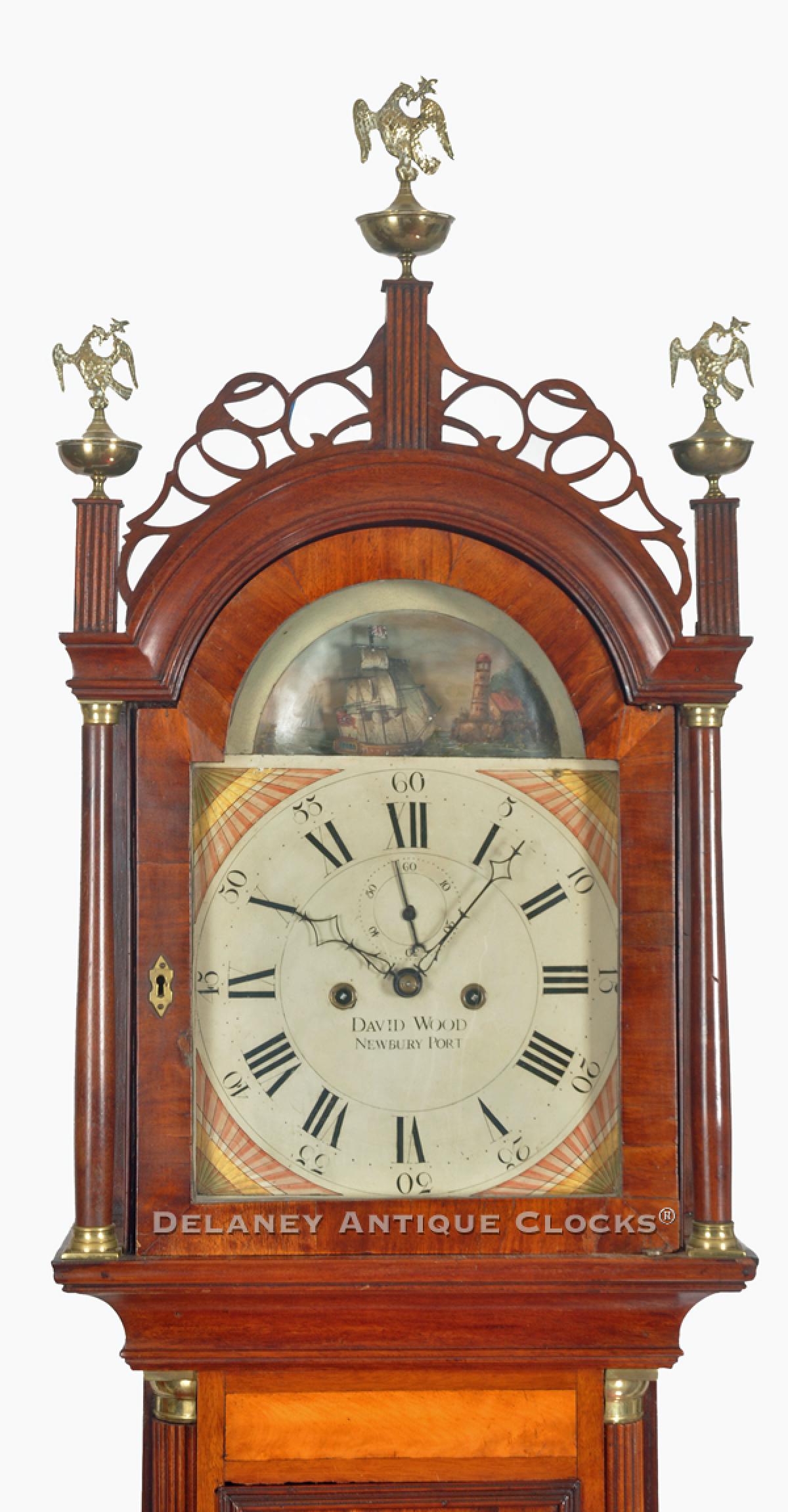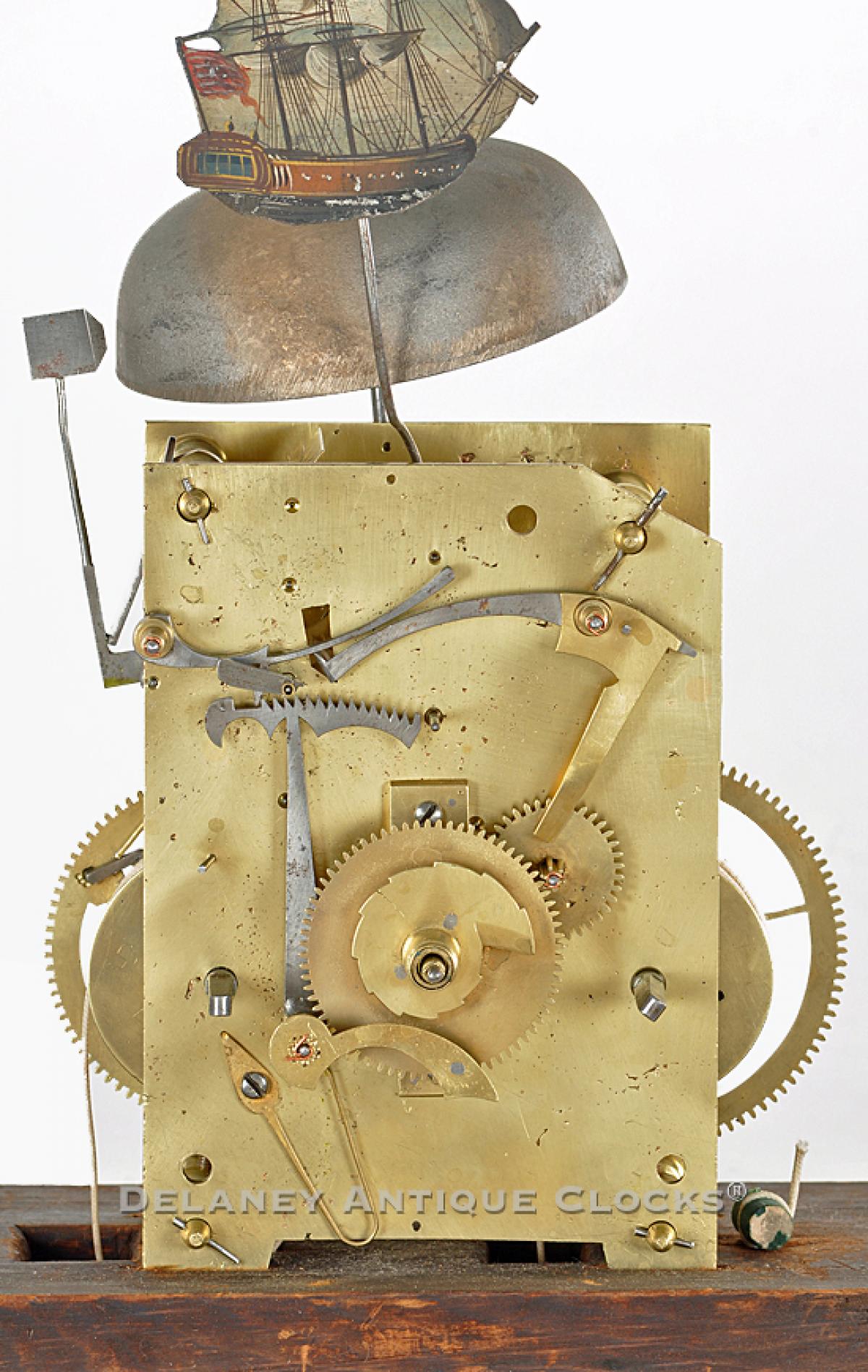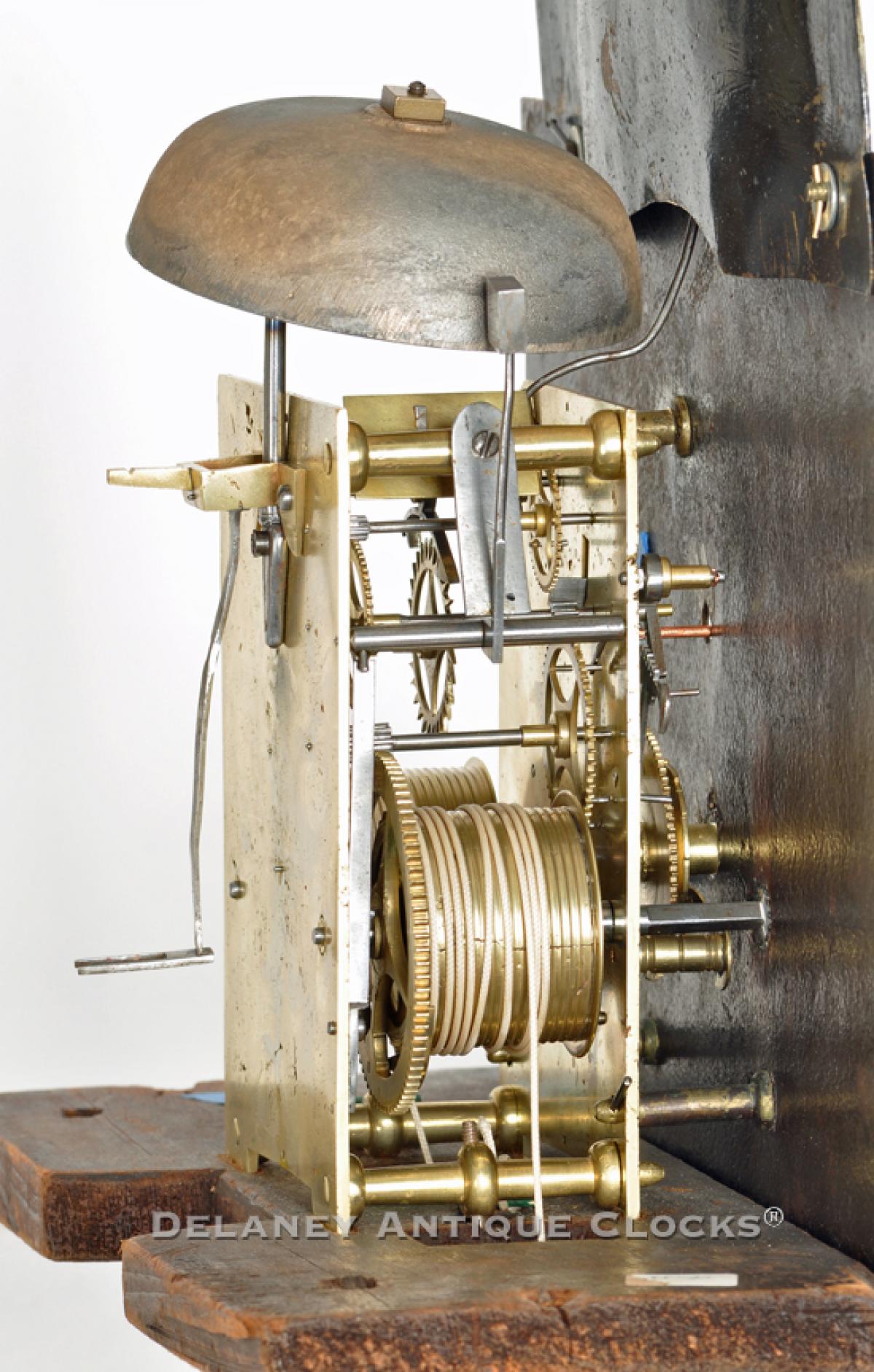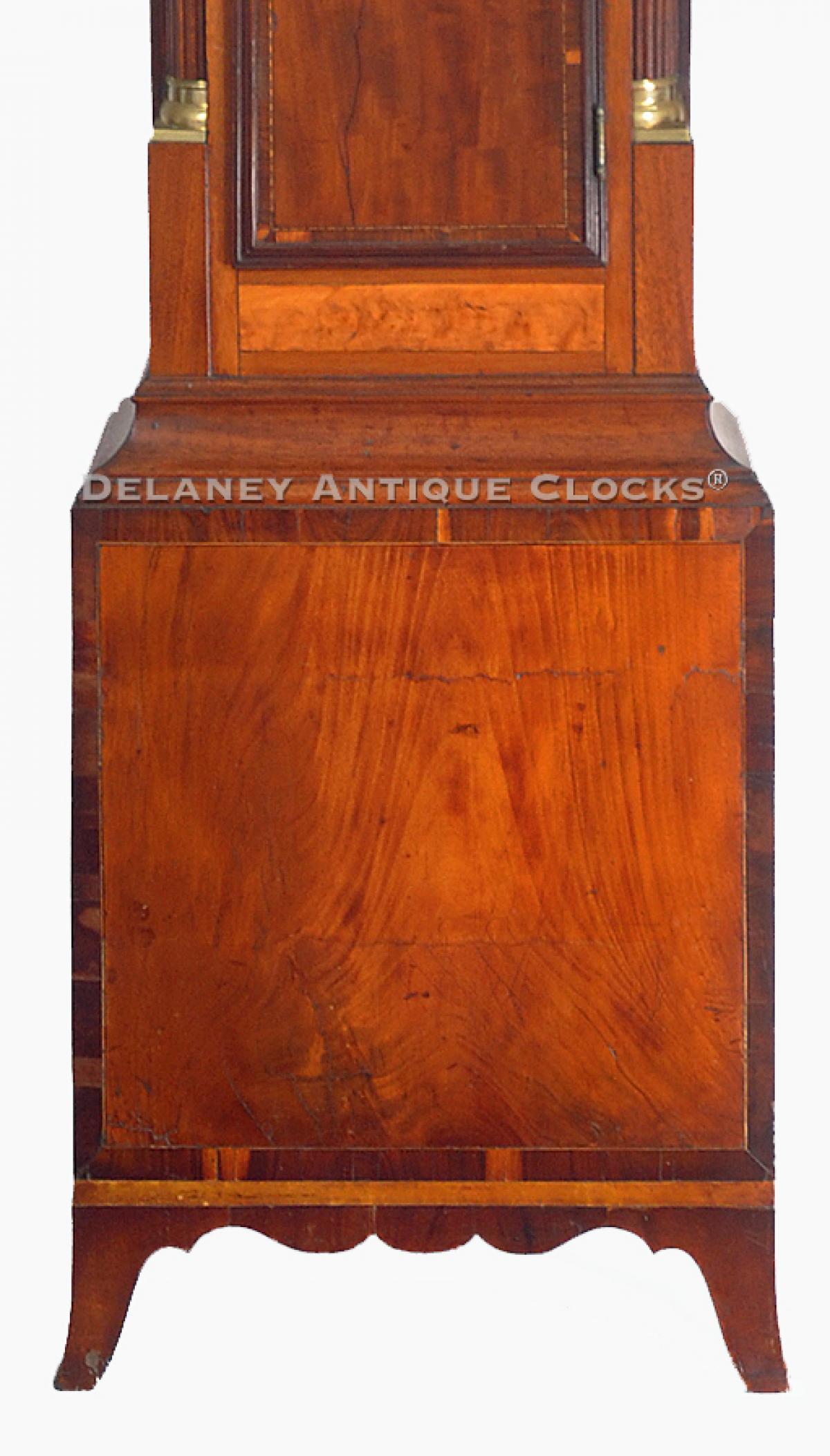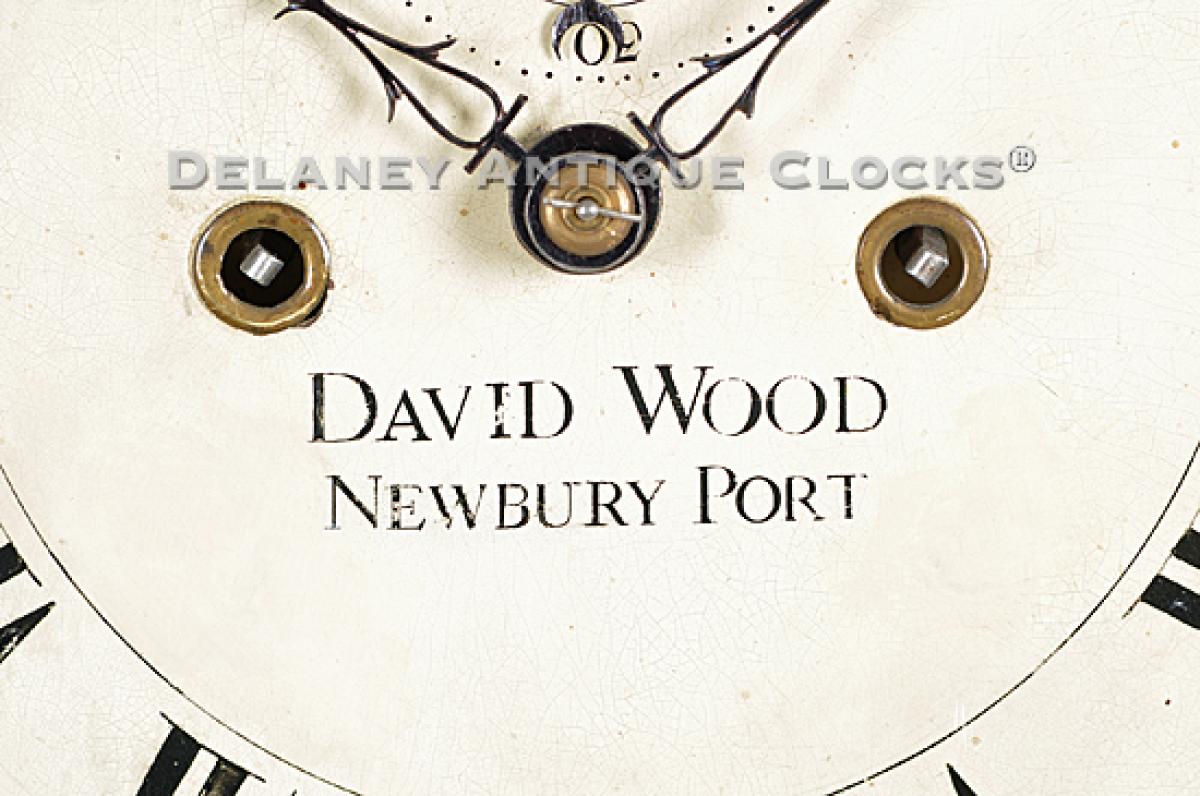David Wood of Newburyport, Massachusetts. A Rocking Ship example originally owned by Patrick Tracy Jackson, an American industrialist. 220052
This is a cross-banded and decoratively inlaid mahogany case. It retains an older finish that is consistent. The case stands on delicately formed bracket feet that incorporate a subtle return. These are applied to a double-stepped base molding. The base is framed in a double cross-banded border. A satinwood line inlay separates the banding from one another. It also visually frames the center panel that features a wonderful selection of figured mahogany veneer. The waist of this clock is long and narrow and features inlaid quarter columns which terminate in brass quarter capitals. The waist door is rectangular and trimmed with applied molding. It shares the same cross-banded design that is exhibited in the base panel. The veneer chosen for the center panel is an excellent selection of wood. The bonnet features a New England-style fret work pattern that is associated with this Maker. It is supported with three finial plinths. Each plinth is decoratively lined with inlaid. A brass ball and spike finial is mounted on top of each plinth. The bonnet columns are also lined inlaid and flank the arched bonnet door. These terminate in brass capitals. The hood door is arched and fitted with glass. It opens to access a painted rocking ship dial.
This colorfully painted iron dial is of local origin and was most likely painted by the Boston artists Spencer Nolen & Samuel Curtis. Similar dials have been found with this artist's signature signed on the back of the dial. This example is signed by the clockmaker, "David Wood," in script lettering below the center arbor. His working location, "NEWBURYPORT," is written in block lettering and is positioned below the signature. In the arch of this dial, one will find the automated feature of a rocking ship. The painted warship is depicted flying a large American flag. This ship moves from side to side with the motion of the pendulum. The painted scene behind the sailing ship includes a tower, which is most likely used as a lighthouse, and the attached cottage of the lighthouse keeper. Both of which are built out on a peninsula at the edge of the sea. The boat is heading out to the open sea. This nautical scene is painted on a convex piece of metal which adds to the visual depth of the scene. The four spandrel areas are decorated with colorfully painted florals. The hours are indicated by large Roman numerals. The five-minute markers are indicated in an Arabic style format. A subsidiary seconds dial is displayed in the traditional location. This dial is fitted directly to the movement without the use of a flaseplate.
This fine weight-driven movement is constructed in brass and is of good quality. Four turned pillars support the two brass plates. Hardened steel shafts support the polished steel pinions and brass gearing. The winding drums are grooved. The escapement is designed as a recoil format. It is weight driven and designed to run for eight days on a full wind. It is a two-train or a time and strike design having a rack and snail striking system. As a result, it will strike each hour on the hour. This is done on a cast iron bell which is mounted above the movement.
This clock was made circa 1815 and stands approximately 89.5 inches tall to the top of the center finial.
This is a cross-banded and decoratively inlaid mahogany case featuring a automated rocking ship dial made by David Wood in Newburyport, MA. The case retains an older finish that is consistent. This colorfully painted iron dial is of local origin and was most likely painted by the Boston artists Spencer Nolen & Samuel Curtis. Similar dials have been found with this artist's signature signed on the back of the dial. The works are weight driven and constructed in brass. It is good quality and designed to run 8-days on a full wind. This clock was made circa 1815 and stands approximately 89.5 inches tall to the top of the center finial.
Inventory number 220052
Provenance.
The history of ownership of this clock is handwritten on a card that is tacked to the inside of the waist door. It is recorded here that this clock was originally purchased by Patrick Tracy Jackson, born in Newburyport on August 14, 1780, and died on September 12, 1849, in Beverly, Massachusetts. Patrick's parents were Jonathan Jackson and Hannah Tracy Jackson. His father, Jonathan, was a merchant and a delegate for Massachusetts in the Continental Congress. Patrick Tracy Jackson was well educated and attended the Drummer Academy. He began his professional career in the maritime trade by putting out to sea on at least four voyages abroad. He then established himself in Boston, specializing in the East and West Indies trades. Patrick married Lydia Cabot in 1810. About 1813, he collaborated with his brother-in-law Francis Cabot Lowell and others in a venture into the textile industry. They were founders of the Boston Manufacturing Company, which was located in Waltham, MA. This was the first integrated textile mill in America in which raw cotton could be converted into finished cloth in the same building. Jackson served as the first manager of this factory and was also a member of the Boston Associates. He was an original investor and stockholder in the Suffolk Bank, which was chartered in 1818. In 1820, he was an instrumental founder of the Merrimack Manufacturing Company located on the Pawtucket Falls on the Merrimack River. This textile mill produced calico cloth. He appointed himself Proprietor of the Locks and Canals of the Merrimack River and later oversaw the construction of the Boston & Lowell Railroad. These developments helped form the nucleus of the town of Lowell, which was incorporated in 1826 and was named after his brother-in-law.
The clock was then passed down to their fifth child, Hannah Lowell Jackson (b. June 20, 1820 – d. June 30, 1879). In 1844, she married Dr. Samuel Cabot (b20 Sept 1815 and d. April 13, 1885). A graduate of Harvard, he was a physician, surgeon, and ornithologist. They had eight children.
The clock passed to their daughter Helen Jackson (Cabot), who was born on January 13, 1856, and died on April 11, 1938. She married Judge Charles Almy. They had six children. She was one of four of the first women to take examinations at Harvard. She was a prime mover on the committee of women, which started the first public playgrounds in Cambridge. She was a member of the Cambridge Parks and Recreation Commission. Her portrait is in the collections of Harvard Art Museum / Fogg Museum.
Elizabeth Mason Almy, the fifth child of Helen and Charle Almy, was born on August 28, 1892, and owned the clock next. She married Dr. Stanley Cobb in 1915. Cobb was a neurologist and is considered by many to be the founder of biological psychiatry in the United States. They had three children, Sidney, Helen, and John.
David Wood was born the son of John Wood (1727-1805) and Eunice (Fellows) Wood (1737-1801) in Newburyport, Massachusetts, on July 5, 1766. It is thought that he may have been apprenticed to either Daniel Balch Senior or to one of the members Mulliken family. All of whom were prominent Clockmakers in this region. David advertised in the Essex Journal and New Hampshire Packet on June 13, 1792, that he had set up a shop in Market Square, near Reverend Andrews Meeting House. Three short years later, he married Elizabeth Bird (1769-1846) of Newbury in 1795. It has become evident that David Wood was also a Retailer. In 1806 he advertised that he had for sale "Willard's best Patent Timepieces, for as low as can be purchased in Roxbury." In 1818, he and Abel Moulton, a local silversmith, moved into the shop formerly occupied by Thomas H. Balch. In 1824 he advertised that he had moved on the westerly side of Market Square opposite the Market House. After his wife's death in 1846, he moved to Lexington to live near his son David, who was a merchant in that town.
It has become quite obvious to us that David Wood was a very successful Clockmaker and Retailer of Clocks. Over the last 35 years of being in the business of selling clocks, we have sold many examples of wall, shelf, and tall case clocks bearing this Maker's signature on the dial.


